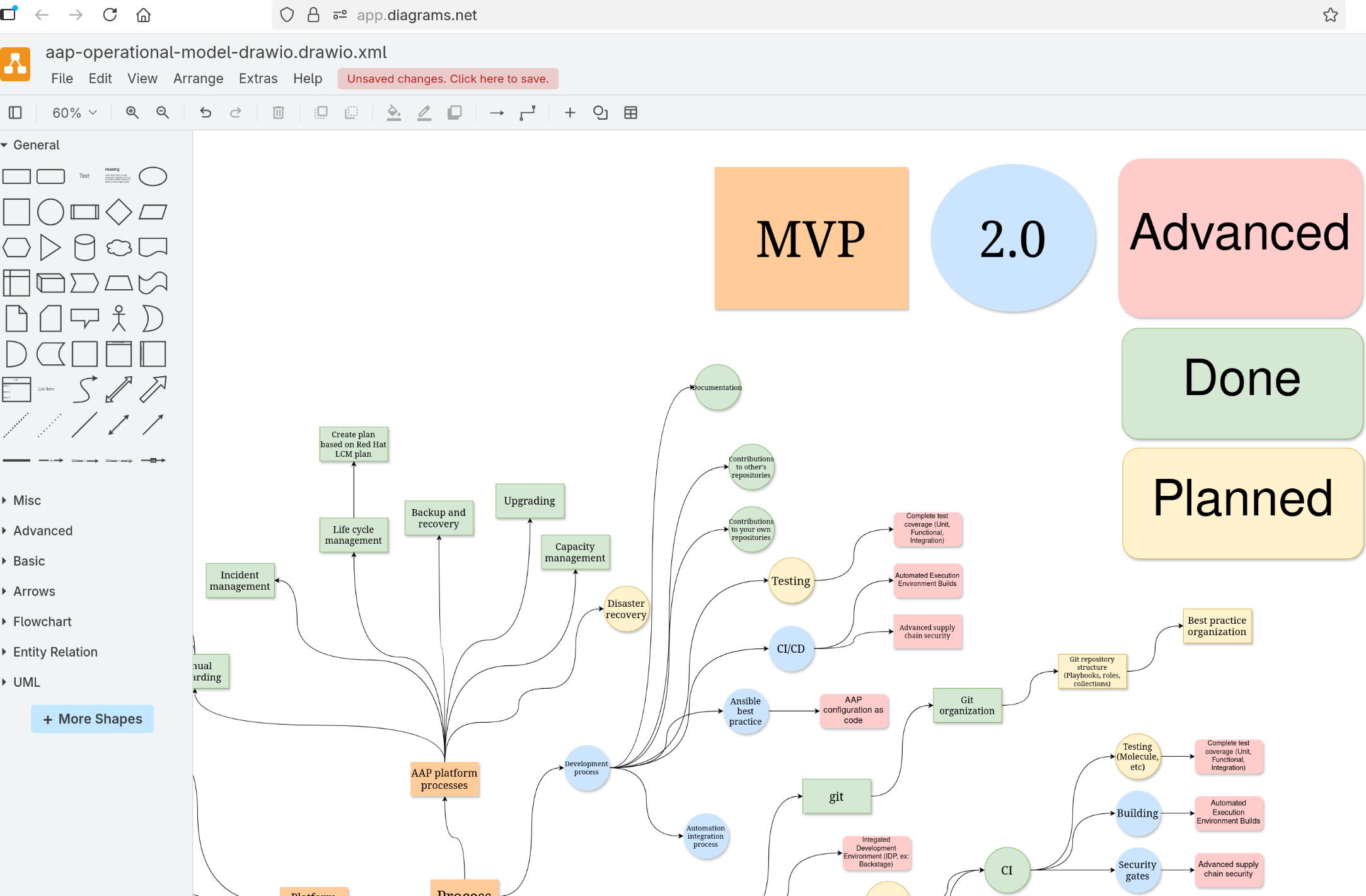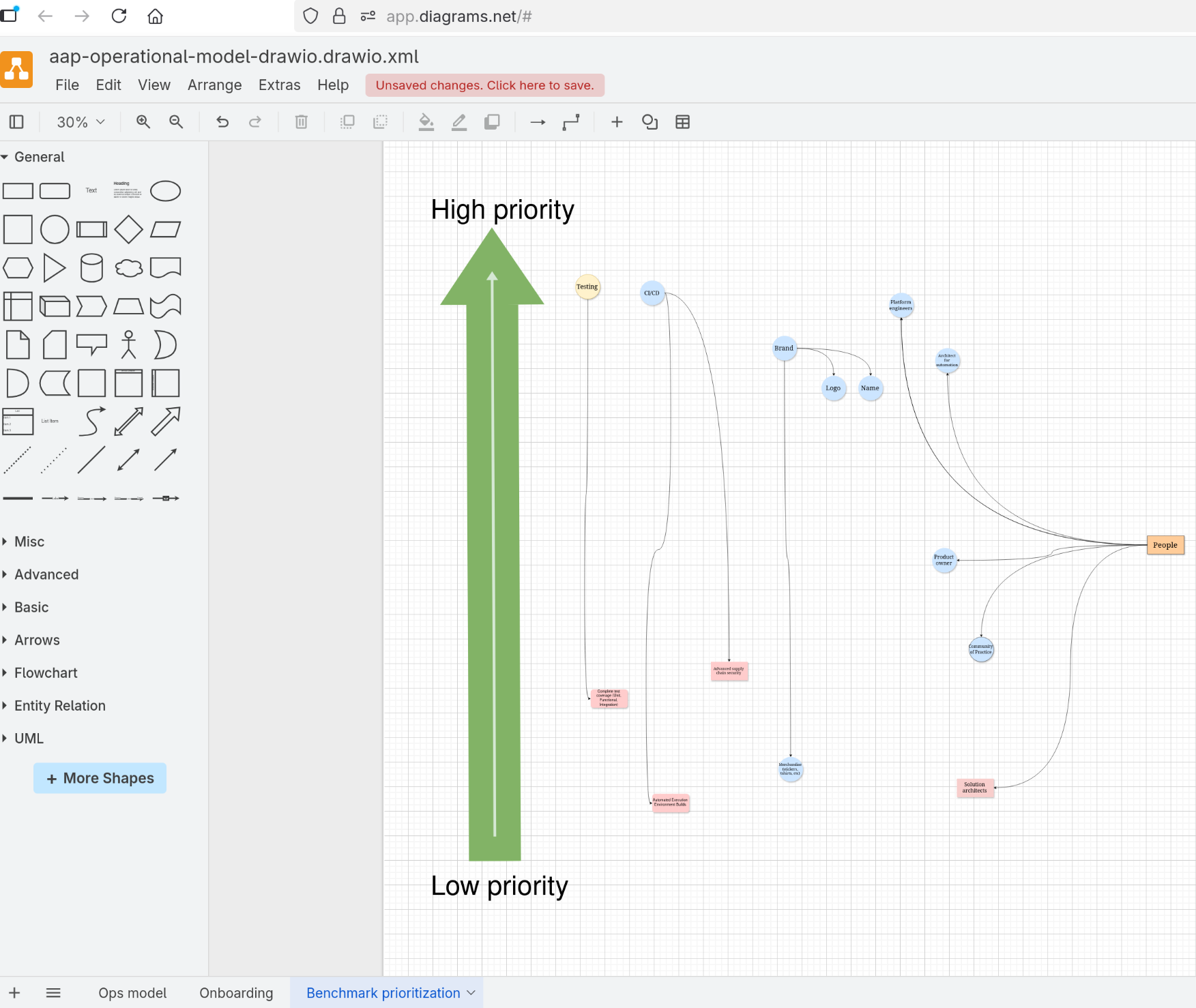An operational model for the Red Hat Ansible Automation Platform
Hello and welcome. This is a good practice based operational model for Ansible Automation Platform. This model is for people who wants inspiration for how you can run a central automation platform based on Ansible Automation Platform.
This model covers good practices and should not be read as a list of things you always need to do. Different organizations are different.
The model, which covers people, process, technology, platform management and strategy is divided between three different advancement levels (1-3). Access these different levels via the menu on the top of this page.
It’s likely that your best fit is a mix of the different levels (MVP, 2.0, Advanced).
For instructions on how you can benchmark yourself against this model, go to the bottom of this page.
1. Minimal Viable Product (MVP)
The MVP version of a platform definition is a common good practice starting point, which we can build on as adoption scales. We are weighing things such as ease-of-adoption and standardization against effort to implement. This is as hands-on experience of the platform is a paramount component of successful adoption. Instead of creating a so-called “big bang release”, which requires significant investments in regards to effort and people, we ensure we have just enough platform features to start getting experience with automating real life use-cases.
2. Two point zero (2.0)
Once there has been some real degree of success and adoption of the platform, it’s time to fine tune the definition for it to be able to meet the requirements of the future. Focus is on more advanced platform and adoption related capabilities. We spend more time standardizing things such as the development experience and onboarding, an investment which pays-off in the long term. The features we now build reduces the effort regarding maintenance and allows a much higher adoption rate of our platform.
3. Advanced
A lot of focus now goes into making sure the platform can grow on an organization-wide scale and make more significant business impact. To cater for organization-wide advanced end-to-end automation, we need to complete the puzzle with things such as an overarching automation strategy and advanced platform features. At the same time we need to spend increased effort on the community we have built around automation. Some final technical capabilities are put in place to ensure we can meet any type of business requirements.
Contribute to the model!
This model is open source. The aim of this project is that it is maintained by people who have first hand experience with that works, and what does not work. If you thought this model was very useful, please consider contributing to it.
Get more information about contributing to the model, here.
Benchmarking yourself against the model.
You can compare what you have yourself today against this model of good practices. Do so by opening this draw.io link.
If the link doesn’t work, you can also following below instructions.
Download the draw.io file to your computer - it contains the graphical model.
Create a free account on https://www.draw.io or you can download and install it locally.
Upload the file into draw.io or open it with your locally installed application.
Using coloring (green for DONE, yellow for PLANNED) to mark what is already done or what you already have planned to do.

Put the resulting gap into the prioritization tab and prioritize the outstanding items.

Use the prioritized outstanding items to inspire you, help prioritize or plan for your platform. If you have no idea how you to do something - Red Hat consulting can help implement the outstanding items.
About us
This initiative was created by the Red Hat EMEA Ansible Launch Team to help customers and partners navigate their journey to automation excellence with the Red Hat Ansible Automation Platform. Through our daily conversations, we’ve identified recurring patterns for success — and common pitfalls — in adopting Ansible. These insights consistently revolve around three key pillars: People, Processes and Technology.
In the spirit of open collaboration, we’ve created this resource to share what we’ve learned. The most important thing to remember is that every organization’s path is unique. Please treat everything here as a source of inspiration — a set of proposals to be discussed, not rules to be followed. The ultimate measure of success is what works for you. We provide the ideas; you build the future.
If you want to get in touch, you can find us on LinkedIn: Magnus Glantz, Christian Jung, Alessandro Grassi.